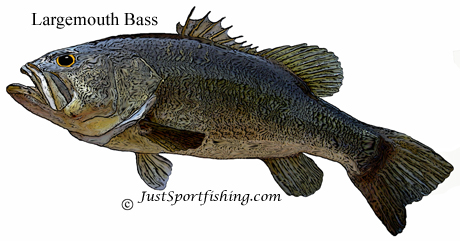|
Home Game Fish Fishing Knots Tackle Tips Videos Pictures Tips Rods & Reels Boats Cook your Catch Articles About Contact |
|
Donate to JustSportfishing.com and help to build the largest fishing information site on the web. Even a dollar or two will keep us building this free site.
|
Largemouth
Bass World
Record
~ 22 Lbs. 4 oz. Caught at Montgomery Lake, GA on June 2, 1932 by angler
George W. Perry Scientific
name
~ Micropterus Salmoides Other
names
~ Black Bass, Largemouth, Bigmouth, Linesides, Florida Bass, Green Bass,
Widemouth bass Identification ~ The Largemouth Bass has a elongated, robust shape when compared to others in the sunfish family, of which the Largemouth belongs. It has a large mouth and the jaw falls beyond the rear of the eye. The color can vary depending on their location but generally they are light green to light brown in color along the back and sides with dark blotches and a white belly and lower sides. A prominent lateral stripe that runs from the snout through the eye to the base of the tail. The dorsal fin has two distinct portions, the spiny portion with 9 or 10 spines, and the ray portion with 12 or 13 soft rays. The largemouth Bass has a broad tail that is only slightly forked.
Size
~ The average angler caught
Largemouth Bass is 10 to 13 inches long and 1 to 2 pounds but fishermen
do encounter Largemouth Bass to 5 pounds. In some habitats Largemouth
Bass are caught in the 5 to 10 pound range but these are less common. Habitat
~ The Largemouth Bass seek cover and can be found in weedy sections,
near logs, stumps, lily pads, docks, large rocks, or anything else that
offers them a shelter from which to ambush their prey. The Largemouth
Bass prefers a water temperature range from 65 F to 85 F . The
Largemouth Bass is found in all types of waters, including swamps,
ponds, lakes, reservoirs, creeks, large rivers, and estuaries. The
Largemouth Bass is native to the Florida Everglades, and due to its
importance as a game fish, has been introduced into many other areas,
making it perhaps the mostly widely distributed fish in the world. It
has been introduced to Mexico, Central and South America, Europe, Guam,
Japan, Lebanon, New Zealand, the Philippines, South Africa, and the
United States. Feeding
Habits
~ The diet of the Largemouth bass is mostly made up of fish including
threadfin shad, bluegills, golden shiners, gizzard shad, sunfish, and
small catfish. Largemouth bass are opportunist feeders and if able will
also feed on crayfish, mice, frogs, snakes, and salamanders.
|


